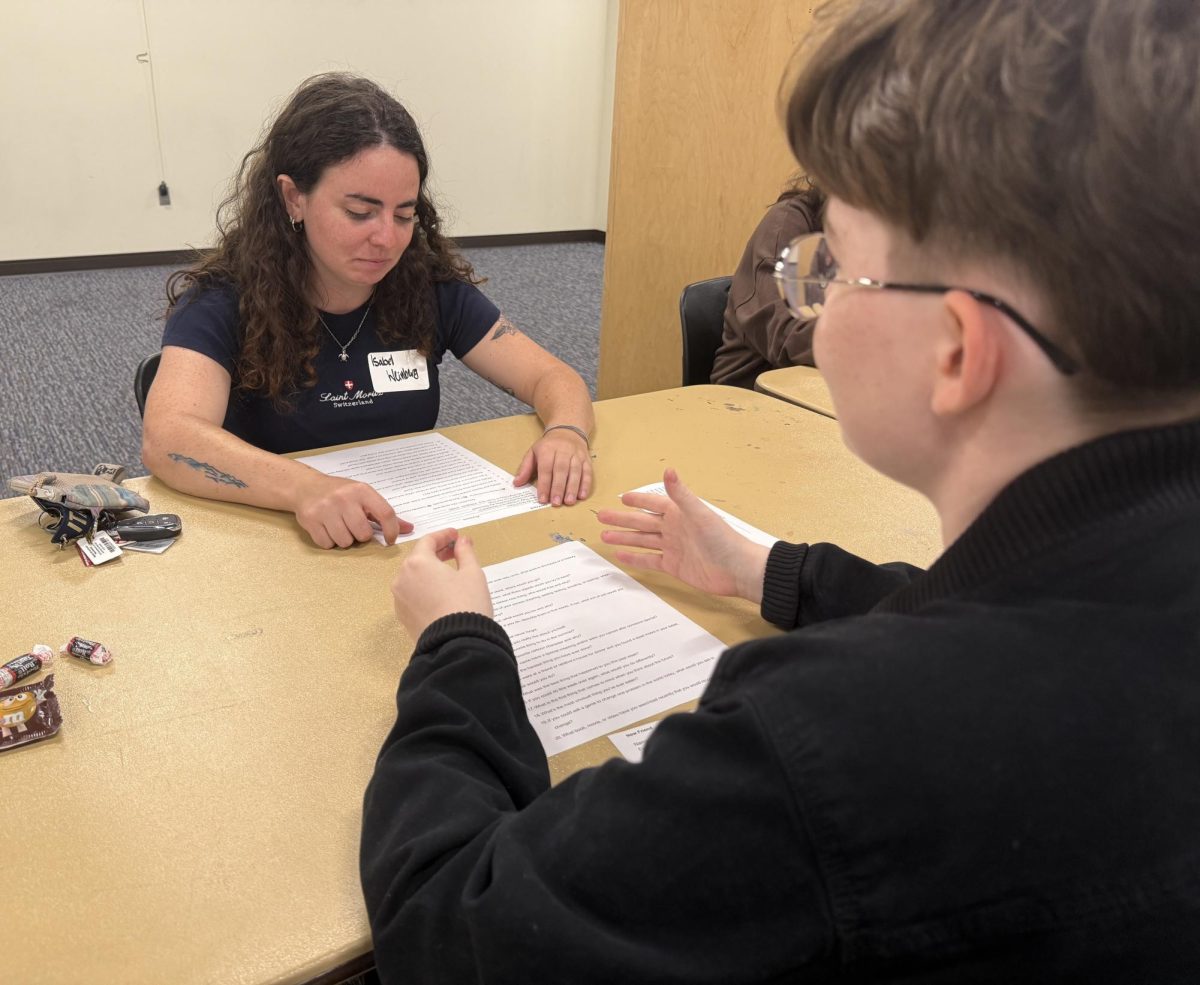Sarah Shadburne
Arts & Features Editor
[email protected]
Black Mountain College Legacy Fellow Jonathon Keats thinks it is time for a Copernican Revolution to hit the arts.
Much like the way scientists stopped seeing Earth as the center of the universe, Keats constructed his Universal Orchestra as a way to play music across the spectrum while getting people to think about their own pedestals.

“I started thinking about the Copernican Revolution as perhaps the most profound moment in human intellectual history, not because of the astronomy, which is remarkable, but this much larger move from thinking of ourselves in every way as being at the center of things to thinking of ourselves as being nowhere special in space or time,” Keats said.
The conceptual philosopher brought his latest thought experiment to life on Thursday in
Lipinsky Hall with the help of students in his music experimentalism class and music faculty members Bill Bares and Wayne Kirby, on a project he has been thinking about since he first wondered what was missing from art that was already present in science.
The mediocrity principle, Keats said, was perhaps the most significant implication of the Copernican Revolution, which states that no place in the universe is special and as a result, what one observes locally can have universal significance.
Keats constructed his orchestra as a means of exploring his interest not only in ultrasonic, infrasonic and subsonic ranges but other modalities all together, as unknown life in the universe may not have evolved ears yet.
“I wanted to, at every level, from the instruments through the content of the performance, to see what assumptions could be dispensed with in order to understand what sort of assumptions we make,” Keats said.

The performance and the instruments were part of a threefold exploration of sound: one of human vocals, one of electromagnetic music and one of gravitational waves. When Keats talks about the spectrum of gravitational waves, he means considering frequency and amplitude as manipulatable phenomena. Because of this, Keats said, one has the basis to express musical ideas.
“In the case of gravitational waves, it’s more abstract for us since we’ve only just detected them, so clearly we are not very sensitive to gravitational waves,” Keats said. “However, you can imagine there might be beings who might be.”
One of the compositions included in the program was inspired by the WOW signal, a famously puzzling radio signal detected from space in 1977 which to this day remains unexplained. Though scientists have debated through the years as to what the mysteriously powerful signal means and where it comes from, Keats said he wondered if it might be music.
“The data sheet has a lot more data than just that peak in radio energy, there are a lot of other channels at other frequencies, so I transcribed that as what seemed to me like it might be a musical composition,” Keats said. “My hypothesis was that the WOW signal itself is just kind of the spotlight on the orchestra, it’s simply that we found the orchestra, but the other channels which have been dismissed as noise actually are the signal possibly, and we need to figure out what the signal is and where the signal is in that and make sense of it.”
Essentially, Keats said he was transcribing what may or may not be a symphony on instruments he had no concept of. Keats said the level of uncertainty only allowed for more room for interpretation on the part of the performers.
“It becomes a way in which to interrogate ourselves and our assumptions about our own intelligence, certainly, but also our own ambiguities that go unacknowledged,” Keats said.
Dylan Metz, a sophomore new media student enrolled in Keats’ music experimentalism class and member of the Universal Orchestra, composed an electronic piece using crickets and a feedback loop.
“It’s a five minute piece and the first half of it is just machine recorded sounds of crickets being played back by a human, but then I have live crickets in a jar that has been mic’d. The idea with this is the humans are playing the chart and the cricket is going to take the solo break,” Metz said.
Metz’s idea with the crickets began as a concept with bats, in which he would create a midi drum pad of five bat sounds, which subsequently the audience would only be able to hear the parts audible to the human ear, leaving some parts only appreciable to bats. When he was unable to incorporate live bats, at Keats’ suggestion, Metz adapted the idea to crickets instead.
“I’ve gained a more broad definition for myself of what is musical and not,” Metz said. “I went into this class pretty open to various types of experimental music or things that other people wouldn’t consider musical and my mind is way more open to the process of doing it.”
Amelia Pate, a senior sculpture student who works in the STEAM studio as part of the orchestra, designed and created her instrument for the performance called a light harp.
The harp is constructed from a wooden frame with strips of window film criss-crossing the front and back of the frame in order to catch, refract and reflect the light as it shines through.
“We’re making music for beings we can’t even begin to conceptualize and that’s what makes it fun, it’s so open-ended,” Pate said. “To a certain extent, perhaps we can’t really understand if we’re playing our instruments correctly.”
Pate said part of her artistic process was recognizing how the human species has evolved to utilize the minimal amount of the brain as possible and said she saw herself simplifying her environment in her own life too.
“In working with Jonathon, I’ve noticed that a lot of his projects seem to be about doing these large experiments that break people out of their patterns of existence and it’s really beautiful how absurd they are,” Pate said.
Keats said he also gained inspiration for the Universal Orchestra by puzzling over a question presented in another project he was working on, the same question introduced by the Fermi Paradox, which asks, “If there are so many intelligent life forms in the universe, where are they?” Keats wondered how he could resolve this question and in turn make extraterrestrial beings feel more welcome.
“If I were an intelligent being from elsewhere in the universe, Andromeda, let’s say, would I come here? Would I even feel welcome?” Keats said. “Then thinking about aliens much closer at hand—aliens south of the border—they don’t feel welcome, so why would I?”
The project ended up being the world’s first Cosmic Welcome Mat which sought to disseminate messages of welcomeness to other life forms in the universe. Keats started thinking that maybe universality was the key ingredient to the artistic Copernican Revolution rather than the mediocrity he thought before.
“I think that the Copernican Revolution in the arts is important in its own right because it could make the arts more than what they have been potentially, but I think the greater importance is a Copernican Revolution societally within our culture.”
Keats points to the rise in tribalism, xenophobia and nationalism as signs that humanity is desperately in need of a cultural shift away from the self-centered models. Conversely, he points to music as being the most popular artistic medium and it having the potential to be a way in which to bring about political change.
“It’s all about a shift in perspective and a shift in your mindset,” Pate said. “The only way to create that unity is to create empathy, and the only way to create empathy is through breaking the patterns.”


![Brooke Pedersen [second from the right] and Luis Reyes [right] hold banners during the Wrap The Woods event.](https://thebluebanner.net/wp-content/uploads/2025/09/ELIZABETH_PRITCHITT_IMG_3470-1200x804.jpg)





















